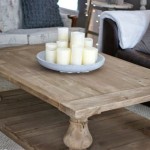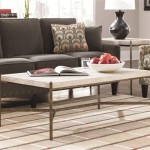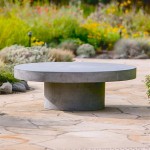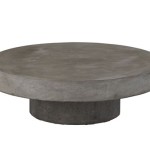What Is The Standard Size of a Side Table?
Side tables, ubiquitous in living rooms, bedrooms, and other living spaces, provide a convenient surface for placing drinks, lamps, books, and other essentials. While the term "side table" encompasses a broad range of designs and dimensions, understanding the typical size parameters can be beneficial when selecting a piece that complements existing furniture and fulfills specific functional needs. There isn't a single, universally mandated "standard" size, but rather a range of common dimensions that manufacturers and designers frequently employ.
The notion of a "standard" size for a side table is more about identifying typical dimensions within prevalent design practices than adhering to a rigid, fixed measurement. These common dimensions are often determined by factors such as the intended use, the height of adjacent furniture (like sofas or beds), and general ergonomic considerations. Therefore, when discussing standard side table sizes, it's crucial to recognize these underlying influences.
This article explores the common dimensions of side tables, categorizing them based on height, width, and depth. It also investigates factors influencing size selection and provides guidance on choosing the right side table for various applications.
Common Side Table Heights
Height is perhaps the most critical dimension of a side table, as it directly impacts its usability in relation to surrounding furniture. Too short, and it becomes difficult to reach items placed on it; too tall, and it can feel visually overpowering and impede access to other objects.
Living Rooms: In living rooms, side tables are frequently positioned alongside sofas and armchairs. As a result, the standard height for a living room side table typically ranges from 22 to 30 inches. This height range usually allows for comfortable access to drinks, remote controls, or reading materials while seated. The ideal height is often dictated by the arm height of the adjacent sofa or armchair; the side table's surface should ideally be at the same height or slightly lower than the armrest.
The rationale behind this height recommendation stems from ergonomic principles. A side table that is level with or slightly below the armrest allows users to place and retrieve items without excessive reaching or straining. This is particularly important for individuals who spend extended periods of time seated in the living room, as it contributes to overall comfort and reduces the risk of repetitive strain injuries.
Bedrooms: Nightstands, which function as side tables in the bedroom, generally align with the height of the mattress. The standard height for a nightstand typically ranges from 24 to 28 inches. This height ensures that items placed on the nightstand, such as lamps, alarm clocks, or books, are within easy reach while lying in bed.
Matching the nightstand height to the mattress height prevents unnecessary stretching or reaching, which can disrupt sleep or cause discomfort. The goal is to create a seamless transition between the bed and the nightstand, allowing users to access essential items without having to sit up or strain their necks. In bedrooms with higher mattresses (often due to pillow tops or platform beds), taller nightstands may be necessary to maintain this ergonomic positioning.
Accent Tables: Accent tables, which serve primarily aesthetic purposes, may deviate from these standard height ranges. These tables, designed to complement a room's decor or highlight a particular feature, can be shorter or taller depending on their specific design and intended function. For example, a tall, slender accent table might be used to display a vase of flowers, while a shorter, wider table could serve as a base for a sculpture or decorative object.
The height of an accent table is less constrained by ergonomic considerations and more influenced by visual balance and stylistic preferences. However, even accent tables should be chosen with some attention to the surrounding furniture and the overall proportions of the room. A disproportionately tall or short accent table can disrupt the harmony of a space and draw unwanted attention to itself.
Typical Side Table Width and Depth
While height is crucial for accessibility, width and depth determine the usable surface area and the overall footprint of the side table. The "standard" width and depth can vary considerably depending on the table's design, intended use, and available space.
Small Spaces: In apartments or smaller living areas, smaller side tables are often preferred. These tables typically have a width and depth of 16 to 22 inches. This compact size allows them to fit neatly next to sofas, chairs, or beds without overwhelming the space. They are ideal for holding a lamp, a drink, or a small book.
The limited surface area of these smaller tables necessitates careful consideration of the items placed on them. Overcrowding a small side table can make it appear cluttered and detract from its functionality. It's often more practical to prioritize essential items and avoid using the surface for storage. In some cases, choosing a side table with a drawer or shelf can provide additional storage without increasing its footprint.
Larger Spaces: In larger rooms, side tables with a width and depth of 22 to 30 inches or more are common. These tables offer ample surface area for multiple items or larger objects. They can accommodate a lamp, a stack of books, a decorative tray, or even a small plant.
The larger dimensions of these side tables allow for greater flexibility in terms of styling and functionality. They can serve as display surfaces for decorative items, provide space for charging electronic devices, or even function as temporary workstations for laptops or tablets. However, it's important to ensure that the size of the side table is proportionate to the surrounding furniture and the overall scale of the room. A side table that is too large can overwhelm a smaller sofa or chair and create a sense of imbalance.
Round vs. Square/Rectangular: The shape of the side table also influences its perceived size and functionality. Round side tables tend to take up less visual space than square or rectangular tables, even if they have similar surface areas. This is because the curved edges of a round table create a softer, more organic feel.
Square or rectangular side tables, on the other hand, often provide more usable surface area and can be more easily positioned against a wall or in a corner. They are also generally more stable than round tables, which can be prone to tipping if overloaded. The choice between a round, square, or rectangular side table ultimately depends on personal preference, the style of the room, and the intended use of the table.
Factors Influencing Side Table Size Selection
Several factors influence the selection of the appropriate side table size. Understanding these considerations will assist in choosing a side table that is both functional and aesthetically pleasing.
Existing Furniture: The size and style of existing furniture are paramount considerations. The side table should complement the height, scale, and design of the sofa, chairs, or bed it will be placed next to. Mismatched proportions can create visual disharmony and detract from the overall aesthetic of the room.
Consider the arm height of the sofa or chair when selecting a side table for the living room. The side table's surface should be at a comparable height to ensure easy access to items placed on it. In the bedroom, consider the height of the mattress when selecting a nightstand. A nightstand that is too short or too tall can be uncomfortable to use and can disrupt the flow of the room.
Room Size and Layout: The size and layout of the room also play a significant role in determining the appropriate size of the side table. In smaller rooms, smaller side tables are generally more suitable, as they take up less space and prevent the room from feeling cluttered. In larger rooms, larger side tables can be used to create a more substantial focal point and provide ample surface area for various items.
Consider the traffic flow within the room when positioning the side table. Ensure that the table does not obstruct pathways or create a tripping hazard. In tight spaces, consider using a side table with a narrow profile or a curved design to maximize space and improve maneuverability.
Intended Use: The intended use of the side table should also be taken into account. If the table will primarily be used to hold a lamp and a drink, a smaller table may suffice. However, if the table will be used to hold multiple items, such as books, magazines, or electronic devices, a larger table may be necessary.
Consider the types of items that you typically place on a side table and choose a table that is appropriately sized to accommodate them. If you frequently use a laptop or tablet while seated on the sofa, consider choosing a side table with a height that allows you to work comfortably without straining your neck or back.
Storage Needs: If storage is a primary concern, consider selecting a side table with drawers, shelves, or a combination of both. These features can provide valuable storage space for items such as remote controls, books, or magazines, helping to keep the room tidy and organized.
Side tables with storage can be particularly useful in smaller living spaces, where maximizing storage is essential. Consider the types of items that you need to store and choose a side table with storage options that are appropriately sized and configured to meet your needs. Side tables with doors or drawers can also help to conceal clutter and create a more streamlined look.

Nill Fremont Nightstand Oak Walnut Furniture

What Is Side Table Dimensions Free Dwg Layakarchitect

Reina Solid Wood Bedside Table Tables Fabuliv

Ellis Solid Wood Bedside Table Sheesham Fabuliv

Angel Furniture Solid Sheesham Wood Classic Coffee Table Standard Honeyfinish

Standard End Table Dimensions With Drawings Upgradedhome Com

Bristol Solid Wood Side Table Bedroom Furniture Sg Singapore Bedandbasics

Low Wooden Coffee Table Ekbote Furniture Ekbotes Logs And Lumbers Pvt Ltd

Height Of A Sofa Table Ashley Furniture Home Office Check More At Http Www Nikkitsfun Com

Standard End Table Dimensions With Drawings Upgradedhome Com
Related Posts








